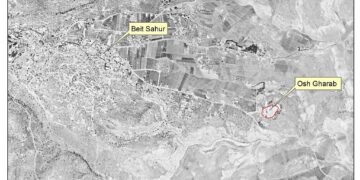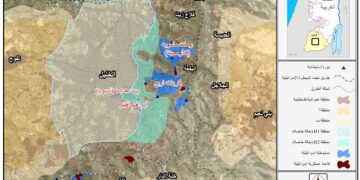Background
The illegal Israeli settlement enterprise in the West Bank has reached detrimental proportions. Since 1990 the number of settlers in the West Bank and East Jerusalem has increased by 109%, reaching over 580,000 people. In 1972 the settler population was just 12,403. The jurisdiction area of settlements covers over 40% of the West Bank despite only accounting for 3% of built up areas. Over 50% of settlements are now populated by national religious and ultra-orthodox Jewish settlers, concentrated in the districts of Jerusalem, Bethlehem, Qalquilya, Salfit, Tubas, Ramallah, Nablus and Hebron. The growing political power of the right heavily influences the settlement enterprise. Religious settlers are increasingly becoming an autonomous group, able to wield violent force and exhibiting a high birth rate. The combination of demographic advantages, political power and a capacity for violence severely threaten any prospect of long-term disengagement of illegal settlements. This is in addition to an extremist ideological stance which also hinders any attempts domestically and internationally to withdraw settlers. The geographical location of religious settlements in the heart of the West Bank effectively nullifies the concept of a two state solution. Analysis by ARIJ indicates that the available built-up area for settlements in 5 out of 11 Palestinian governorates in the West Bank exceeds that area available for the Palestinian population. Even more, if to consider the master plan areas made available by the Israeli civil administration for the Israeli settlements expansion plans, this figure (5) will reach 8 out of 11, providing the foundations for a majority Jewish population in Palestinian territory. See Table 1 & Map 1 indicates that the available built-up area for settlements in 5 out of 11 Palestinian governorates in the West Bank exceeds that area available for the Palestinian population. Even more, if to consider the master plan areas made available by the Israeli civil administration for the Israeli settlements expansion plans, this figure (5) will reach 8 out of 11, providing the foundations for a majority Jewish population in Palestinian territory. See
|
Table 1: Israeli Settlements built-area VS Palestinian built-up area in West Bank Governorates.
|
|
Governorate
|
Governorate Area (km)²
|
Palestinian Built-uparea(km²)
|
Israeli Settlements Built-up Area (km²)
|
IsraeliSettlements Master Plan Area (km²)
|
|
Jenin
|
573
|
27.872
|
3.959
|
22.766
|
|
Tubas
|
366
|
5.17
|
7.518
|
12.532
|
|
Nablus
|
614
|
25.438
|
16.248
|
25.709
|
|
Tulkarem
|
245
|
19.101
|
3.619
|
5.15
|
|
Qalqilyah
|
174
|
8.466
|
11.77
|
25.39
|
|
Salfit
|
202
|
8.719
|
18.147
|
37.959
|
|
Jericho
|
609
|
7.99
|
23.425
|
77.305
|
|
Ramallah
|
849
|
47.85
|
31.268
|
61.233
|
|
Jerusalem
|
354
|
35.646
|
40.011
|
118.72
|
|
Bethlehem
|
608
|
25.37
|
18.158
|
40.697
|
|
Hebron
|
1068
|
83.224
|
14.142
|
58.802
|
|
Total
|
5661
|
294.846
|
188.266
|
486.262
|
Source: ARIJ GIS Unit-2009
Growing Social and Political influence of Religious Right
All settlements, whether religious or non-religious, serve a political objective for Israel insomuch as they occupy Palestinian land, annex resources and are surrounded by a web of infrastructure that creates Palestinian enclaves in the West Bank. The increase in settlements occupied by the religious right is worrying because it is explicitly linked at a political level to the creation of a ‘greater Israel’ which would mean annexing all of Palestine. This is related to the ideology of religious Zionists who believe God granted Jews eternal property rights over all of historic Palestine. The growth of extremist settlers and the decrease in secular settlers is a disturbing trend. National religious settlers comprise 80% of the settler population in the West Bank east of the Segregation wall. National religious and ultra-orthodox settlers account nearly entirely for the increase in settler population between 1997-2003, which numbered 80,000 people. Secular settlers are increasingly relocating to Israel proper
This is a political and demographic issue. For example, in the general population of Israel, totally secular Israelis have declined from 23% to 17% of the population in the last 10 years. Nearly 32% of Israelis between 18-30 are now national-religious or ultra orthodox. Religious Jews have on average 6 children whilst secular Jews average around 2. This is significantly changing the demographic balance of Israeli society which in turn affects politics and the settlement industry..
Politics and the Army
Politically, the religious right has continued to make significant headway. Parties such as Shas, United Torah Judaism, National Union and the Jewish home have a tangible influence in parliament Ultra orthodox and national religious politicians hold more than a fifth of seats in the Knesset and represent 40% of the ruling coalition. Under Netanyahu, 6 Likud parliamentarians are national-religious and nearly a third of the Likud’s 3,000 member central committee is connected to national religious groups. The religious right therefore forms a significant social group for votes and passionately promotes the illegal settlement enterprise. Indeed a former West Bank commander has noted that the settler movement is the strongest lobby in Israel. Members of National Union such as Aryeh Eldad often profess ideas of ethic cleansing, apartheid policies and racism. For example, Eldad was quoted as saying during the evacuation of an illegal outpost in the West Bank that; ‘it was sad that the army was treating real human beings as if they were Arabs’.
The infiltration of the Israeli army by the religious right is also detrimental to dismantling settlements. An Israeli military analyst estimates that 40% of combat units and junior army officers are now religious. Interviews with combat soldiers in the attack on Gaza in 2008-2009 reveal that Rabbis were often seen on the battlefield and delivered pre-battle speeches which emphasized the notion of a holy biblical war. The religious right is vehemently opposed to territorial compromise and given that the army is usually responsible for removing outposts and settlers, a large composition of religious soldiers renders the prospect of disengagement doubtful. Settlers, unlike other soldiers, also tend to serve in their local unit. This policy effectively means that radical settlers take over the army in areas of religious settlements, further strengthening the position of the religious right. An interview with a secular reservist (ICG) reveals this trend; ‘there’s a revolution in the ranks; 12% of the population is now dominating the lower army command. In ten years, senior commanders will be largely national religious as well’. Indeed as a Rabbi in Jerusalem’s Old City mentions; ‘if you control the army, you control the country’.
Violent opposition to settlement dismantlement and territorial compromise is common amongst settlers of the religious right. From the assassination of Yitzhak Rabin, the murder of worshippers in the Ibrahimi Mosque in Hebron and the constant and daily attacks, abuse and destruction aimed at Palestinians throughout the West Bank, but most notably in Hebron and the Nablus region, the religious right continues to use violence to enforce its vision of ‘greater Israel’.
The demographic growth of the religious right, their increasing political influence and their increasing presence in the army, are all ominous signs for long-term disengagement of settlements and ending the occupation of Palestine. Indeed, the growing influence of the religious right together with their willingness to use violence makes the chances of successful disengagement of religious settlements next to impossible. Given that religious settlements are located in the heart of what would be a Palestinian state, this is a worrying feature of the religious right. Despite the illogical ideological beliefs of religious settlers, their ability to become entrenched in the political establishment and key institutions such as the army, in addition to their demographic growth, means that these racist viewpoints are increasingly dictating the direction of the settlement enterprise.















